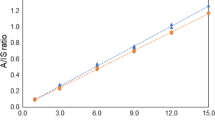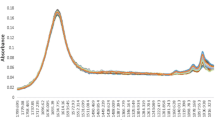Abstract
During the production process of beer, it is of utmost importance to guarantee a high consistency of the beer quality. For instance, the bitterness is an essential quality parameter which has to be controlled within the specifications at the beginning of the production process in the unfermented beer (wort) as well as in final products such as beer and beer mix beverages. Nowadays, analytical techniques for quality control in beer production are mainly based on manual supervision, i.e., samples are taken from the process and analyzed in the laboratory. This typically requires significant lab technicians efforts for only a small fraction of samples to be analyzed, which leads to significant costs for beer breweries and companies. Fourier transform mid-infrared (FT-MIR) spectroscopy was used in combination with nonlinear multivariate calibration techniques to overcome (i) the time consuming off-line analyses in beer production and (ii) already known limitations of standard linear chemometric methods, like partial least squares (PLS), for important quality parameters Speers et al. (J I Brewing. 2003;109(3):229–235), Zhang et al. (J I Brewing. 2012;118(4):361–367) such as bitterness, citric acid, total acids, free amino nitrogen, final attenuation, or foam stability. The calibration models are established with enhanced nonlinear techniques based (i) on a new piece-wise linear version of PLS by employing fuzzy rules for local partitioning the latent variable space and (ii) on extensions of support vector regression variants (𝜖-PLSSVR and ν-PLSSVR), for overcoming high computation times in high-dimensional problems and time-intensive and inappropriate settings of the kernel parameters. Furthermore, we introduce a new model selection scheme based on bagged ensembles in order to improve robustness and thus predictive quality of the final models. The approaches are tested on real-world calibration data sets for wort and beer mix beverages, and successfully compared to linear methods, showing a clear out-performance in most cases and being able to meet the model quality requirements defined by the experts at the beer company.

Workflow for calibration of non-Linear model ensembles from FT-MIR spectra in beer production










Similar content being viewed by others
References
Speers RA, Rogers P, Smith B. Non-linear modelling of industrial brewing fermentations. J I Brewing 2003;109(3):229–235.
Zhang Y, Jia S, Zhang W. Predicting acetic acid content in the final beer using neural networks and support vector machine. J I Brewing 2012;118(4):361–367.
McMurrough M, Lynch V, Murray F, Kearney M. A comparison of alternative high-performance liquid chromatographic systems for measuring bitterness in beer. J Am Soc Brew Chem 1987;45:6–13.
de Keukeleire D. Fundamentals of beer and hop chemistry. Quim Nova 2000;23(1):108–112.
Polshin E, Aernouts B, Saeys W, Delvaux F, Delvaux FR, Saison D, Hertog M, Nicolai BM, Lammertyn J. Beer quality screening by FT-IR spectrometry: impact of measurement strategies, data pre-processings and variable selection methods. J Food Eng 2011;106(3):188–198.
Lachenmeier DW. Rapid quality control of spirit drinks and beer using multivariate data analysis of fourier transform infrared spectra. Food Chem 2007;101(2):825–832.
Christensen J, Ladefoged AM, Nrgaard L. Rapid determination of bitterness in beer using fluorescence spectroscopy and chemometrics. J I Brewing 2012;111(1):3–10.
Grassi S, Amigo JM, Lyndgaard CB, Foschino R, Casiraghi E. Beer fermentation: monitoring of process parameters by FT-NIR and multivariate data analysis. Food Chem 2014;155:279–286.
Haenlein M, Kaplan AM. A beginner’s guide to partial least squares (PLS) analysis. Und Stat 2004;3(4): 283–297.
Brazdil P, Giraud-Carrier C, Soares C, Vilalta R. Metalearning. Berlin Heidelberg: Springer; 2009.
Bleier Z, Brouillette C, Carangelo R. A monolithic interferometer for FT-IR spectroscopy. Spectroscopy 1999;14(10):46–49.
Griffiths PR, De Haseth JA. Fourier Transform Infrared Spectrometry, 2nd edn. New Jersey: Wiley; 2007.
Jolliffe IT. Principal Component Analysis. Berlin Heidelberg New York: Springer Verlag; 2002.
Brereton RG. Chemometrics: Data Analysis for the Laboratory and Chemical Plant. New Jersey: Wiley; 2003.
Varmuza K, Filzmoser P. Introduction to Multivariate Statistical Analysis in Chemometrics. Boca Raton: CRC Press; 2009.
Otto M. Chemometrics, 2nd edn. New Jersey: Wiley; 2007.
Mark H, Workman J. Chemometrics in Spectroscopy. The Netherlands: Academic Press; 2007.
Cernuda C, Lughofer E, Hintenaus P, Märzinger W. Enhanced waveband selection in NIR spectra using enhanced genetic operators. J Chemometr 2014;28(3):123–136.
Rosipal R. Kernel partial least squares for nonlinear regression and discrimination. Neural Netw World 2003; 13(3):291–300.
Cernuda C, Lughofer E, Hintenaus P, Märzinger W, Reischer T, Pawlicek M, Kasberger J. Hybrid adaptive calibration methods and ensemble strategy for prediction of cloud point in melamine resin production. Chemometr Intell Lab 2013;126:60–75.
Lughofer E. Evolving Fuzzy Systems, —Methodologies, Advanced Concepts and Applications. Berlin Heidelberg: Springer; 2011.
Lughofer E, Cernuda C, Kindermann S, Pratama M. Generalized smart evolving fuzzy systems. Evol Sys 2015;6(4):269–292.
Krishnamoorthy K, Mathew T. Statistical Tolerance Regions: Theory, Applications, and Computation. New Jersey: Wiley; 2009.
Mahalanobis PC. On the generalised distance in statistics; 1936.
Gray RM. Vector quantization. IEEE ASSP Mag 1984;1(2):4–29.
Lughofer E, Sayed-Mouchaweh M. Autonomous data stream clustering implementing incremental split-and-merge techniques — towards a plug-and-play approach. Inform Scie 2015;204:54–79.
Angelov PP, Filev D. An approach to online identification of Takagi-Sugeno fuzzy models. IEEE T Syst Man Cy B 2004;34(1):484–498.
Lughofer E. FLEXFIS: A robust incremental learning approach for evolving TS fuzzy models. IEEE T Fuzzy Syst 2008;16(6):1393–1410.
Vapnik V. Statistical Learning Theory. New York: Wiley; 1998.
Schölkopf B, Smola AJ. Learning with Kernels—Support Vector Machines, Regularization, Optimization and Beyond. London: MIT Press; 2002.
Hofmann T, Scholkopf B, Smola AJ. Kernel methods in machine learning. Ann Stat 2009;36(3):1171–1220.
Smola AJ, Schölkopf B. A tutorial on support vector regression. Stat Comp 2004;14:199–222.
Hsu C-W, Chang C-C, Lin C-J. 2010. A practical guide to support vector classification.
Stone M. Cross-validatory choice and assessment of statistical predictions. J R Stat Soc 1974;36(1):111–147.
Breiman L. Bagging predictors. Mach Learn 1996;24(2):123–140.
Bras LP, Lopes M, Ferreira AP, Menezes JC. A bootstrap-based strategy for spectral interval selection in pls regression. J Chemometr 2008;22(11–12):695–700.
Efron B, Tibshirani R. Improvements on cross-validation: the.632 + bootstrap method. J Am Stat Assoc 1997;92(438):548–560.
Breiman L. Random forests. Mach Learn 2001;45(1):5–32.
Centner V, Massart D-L, de Noord OE, de Jong S, Vandeginste BM, Sterna S. Elimination of uninformative variables for multivariate calibration. Anal Chem 1996;68(21):3851–3858.
Cai W, Li Y, Shao X. A variable selection method based on uninformative variable elimination for multivariate calibration of near-infrared spectra. Chemometr Intell Lab 2008;90:188–194.
Andersen CR, Bro R. Variable selection in regression—a tutorial. J Chemometr 2010;24(11-12):728–737.
Rinnan A, van den Berg F, Engelsen SB. Review of the most common pre-processing techniques for near-infrared spectra. Trend Anal Chem 2009;28(10):1201–1222.
Hastie T, Tibshirani R, Friedman J. The Elements of Statistical Learning: Data Mining, Inference and Prediction, 2nd ed. New York Berlin Heidelberg: Springer; 2009.
Tibshirani R. Regression shrinkage and selection via the lasso. J R Stat Soc 1996;58:267–288.
Zou H, Hastie T. Regularization and variable selection via the elastic net. J R Stat Soc 2005;67(2):301–320.
Hastie T, Tibshirani R, Friedman J. Regularized paths for generalized linear models via coordinate descent. J Stat Softw 2010;33(1).
Hastie T, Tibshirani R, Friedman J. Pathwise coordinate optimization. Ann Appl Stat 2007;1(2):302–332.
Cernuda C, Lughofer E, Maerzinger W, Kasberger J. NIR-based quantification of process parameters in polyetheracrylat (PEA) production using flexible non-linear fuzzy systems. Chemometr Intell Lab 2011;109(1):22–33.
Acknowledgments
Financial support was provided by (i) the Austrian research funding association (FFG) under the scope of the COMET programme within the research project Industrial Methods for Process Analytical Chemistry - From Measurement Technologies to Information Systems (imPACts) (contract #843546), (ii) the Basque Government through the ELKARTEK and BERC 2014-2017 programs, and (iii) the Spanish Ministry of Economy and Competitiveness MINECO: BCAM Severo Ochoa accreditation SEV-2013-032. This publication reflects only the authors’ views.
Author information
Authors and Affiliations
Corresponding author
Ethics declarations
This paper does not contain any studies with human participants or animals performed by any of the authors.
Conflict of interests
The authors declare that they have no conflict of interest.
Additional information
Published in the topical collection Process Analytics in Science and Industry with guest editor Rudolf W. Kessler.
Electronic supplementary material
Below is the link to the electronic supplementary material.
Rights and permissions
About this article
Cite this article
Cernuda, C., Lughofer, E., Klein, H. et al. Improved quantification of important beer quality parameters based on nonlinear calibration methods applied to FT-MIR spectra. Anal Bioanal Chem 409, 841–857 (2017). https://doi.org/10.1007/s00216-016-9785-4
Received:
Revised:
Accepted:
Published:
Issue Date:
DOI: https://doi.org/10.1007/s00216-016-9785-4




